The Impact of an Enterprise’s Intellectualization on Its Leadership Potential
Abstract
:1. Introduction
- (1)
- (2)
- Second, as a manageable structure, characterized by the ability of managers to understand and manage key processes, business strategy, and the speed with which the business is able to find, respond to, and fix problems that arise [10];
- (3)
- Third, as a stimulating effect of intellectual capital on the economic object that constantly attracts, produces, and distributes components of intellectual potential, thereby supporting the transfer and dissemination of intellectualization, and the promotion of new and specialized knowledge, goods, and services [11];
- (4)
- Fourth, as the active use of the unique abilities of individuals to create innovative products and information technology, the widespread introduction of intellectual components, the creation and development of new industries and applications of knowledge [12].
2. Literature Review
2.1. Peculiarities of Intellectualization in the Context of Leadership Potential Formation
2.2. Factors of Enterprise Intellectualization and Leadership in Today’s Environment
3. Materials and Methods
- -
- the level of education and qualifications of the staff;
- -
- common understanding of the mission, main goal, objectives, and vision of a business;
- -
- knowledge and understanding of the key success factors and performance indicators;
- -
- understanding the risks and arising problems;
- -
- knowledge and understanding of business development methods and technologies;
- -
- -
- a climate conducive to the learning and intellectualization of a business;
- -
- flexible communication channels;
- -
- opportunities to attract progressive forms and methods of personnel training;
- -
- flexible mechanisms of remuneration, stimulation, and motivation of personnel;
- -
- financial capabilities of personnel;
- -
- -
- ability to quickly make and implement various decisions;
- -
- ability for group learning and self-development;
- -
- ability to exchange information;
- -
- ability to adopt and apply best business practices;
- -
- ability to resolve conflicts;
- -
- ability to create, implement, and develop own intellectual assets (patents, copyrights, know-how, etc.);
- -
- (1)
- if the level is from 0 to 0.20 (crisis), then the pre-crisis level of LP is observed;
- (2)
- if the level is between 0.21 and 0.37 (low), then there is a low LP;
- (3)
- if the level is between 0.38 and 0.63 (sufficient), then a normal LP level is observed;
- (4)
- if the level is between 0.64 and 0.80 (acceptable), then an average (stable) level of LP is observed;
- (5)
- if the level is from 0.81 to 1 (high), then there is a high (innovative) level of LP.
4. Results
5. Discussion
6. Conclusions
Author Contributions
Funding
Institutional Review Board Statement
Informed Consent Statement
Data Availability Statement
Conflicts of Interest
References
- Pyka, A. Dedicated innovation systems to support the transformation towards sustainability: Creating income opportunities and employment in the knowledge-based digital bioeconomy. J. Open Innov. 2017, 3, 27. [Google Scholar] [CrossRef]
- Li, Y.; Song, Y.; Wang, J.; Li, C. Intellectual capital, knowledge sharing, and innovation performance: Evidence from the Chinese construction industry. Sustainability 2019, 11, 2713. [Google Scholar] [CrossRef] [Green Version]
- Hadad, S. Knowledge economy: Characteristics and dimensions. Manag. Dyn. Knowl. Econ. 2017, 5, 203–225. [Google Scholar] [CrossRef] [Green Version]
- An, M.H.; Ri, G.Y.; Rim, G.N. Intellectual product and method of assessing the competitiveness of an enterprise with it. J. Knowl. Econ. 2020, 11, 1059–1085. [Google Scholar] [CrossRef]
- Haque, A.U.; Sher, A.; Urbański, M. Is the role of authentic leadership effective in managing occupational stress and psychological capital? Forum Sci. Oeconomia 2020, 8, 59–77. [Google Scholar]
- Ślusarczyk, B. Prospects for the shared services centers development in Poland in the context of human resources availability. Pol. J. Manag. Stud. 2017, 15, 218–231. [Google Scholar] [CrossRef]
- Pedro, E.; Leitão, J.; Alves, H. Back to the future of intellectual capital research: A systematic literature review. Manag. Decis. 2018, 56, 2502–2583. [Google Scholar] [CrossRef]
- Adesina, K.S. Bank technical, allocative and cost efficiencies in Africa: The influence of intellectual capital. N. Am. J. Econ. Financ. 2019, 48, 419–433. [Google Scholar] [CrossRef]
- Sardo, F.; Serrasqueiro, Z. A European empirical study of the relationship between firms’ intellectual capital, financial performance and market value. J. Intellect. Cap. 2017, 18, 771–788. [Google Scholar] [CrossRef]
- Meekaewkunchorn, N.; Szczepańska-Woszczyna, K.; Muangmee, C.; Kassakorn, N.; Khalid, B. Entrepreneurial orientation and sme performance: The mediating role of learning orientation. Econ. Sociol. 2021, 14, 294–312. [Google Scholar]
- Xu, J.; Li, J. The impact of intellectual capital on SMEs’ performance in China: Empirical evidence from non-high-tech vs. high-tech SMEs. J. Intellect. Cap. 2019, 20, 488–509. [Google Scholar] [CrossRef]
- Zahedi, M.R.; Khanachah, S.N. The effect of knowledge management processes on organizational innovation through intellectual capital development in Iranian industrial organizations. J. Sci. Technol. Policy Manag. 2020, 12, 86–105. [Google Scholar] [CrossRef]
- Setini, M.; Yasa, N.N.K.; Gede Supartha, I.W.; Ketut Giantari, I.; Rajiani, I. The passway of women entrepreneurship: Starting from social capital with open innovation, through to knowledge sharing and innovative performance. J. Open Innov. 2020, 6, 25. [Google Scholar] [CrossRef] [Green Version]
- Eljaoued, W.; Yahia, N.B.; Saoud, N.B.B. A qualitative-quantitative resilience assessment approach for socio-technical systems. Procedia Comput. Sci. 2020, 176, 2625–2634. [Google Scholar] [CrossRef]
- Pasnicu, D.; Ciobanu, G. Quality of employment in small and medium enterprises in Romania. Rev. Manag. Comp. Int. 2018, 19, 64–76. [Google Scholar] [CrossRef]
- Szczepańska-Woszczyna, K. Strategy, Corporate Culture, Structure and Operational Processes as the Context for the Innovativeness of an Organization. Found. Manag. 2018, 10, 33–44. [Google Scholar] [CrossRef] [Green Version]
- Shkoda, T.; Tepliuk, M.; Sahaidak, M. Intellectual potential management in forming strategic partnership of science-business-education. Balt. J. Econ. Stud. 2020, 6, 221–232. [Google Scholar] [CrossRef]
- Shvydanenko, O.; Sica, E.; Busarieva, T. Creativity as the new production factor of the world economy. Manag. Theory Stud. Rural Bus. Infrastruct. Dev. 2019, 41, 127–134. [Google Scholar] [CrossRef]
- Konrad, G.; Szelenyi, I. Intellectuals and domination in post-communist societies. In Social Theory for a Changing Society; Routledge: London, UK, 2019; pp. 337–372. [Google Scholar]
- Polese, F.; Botti, A.; Grimaldi, M.; Monda, A.; Vesci, M. Social innovation in smart tourism ecosystems: How technology and institutions shape sustainable value co-creation. Sustainability 2018, 10, 140. [Google Scholar] [CrossRef] [Green Version]
- Hussinki, H.; Ritala, P.; Vanhala, M.; Kianto, A. Intellectual capital, knowledge management practices and firm performance. J. Intellect. Cap. 2017, 18, 904–922. [Google Scholar] [CrossRef]
- Al-Gasawneh, J.A.; Anuar, M.M.; Dacko-Pikiewicz, Z.; Saputra, J. The impact of customer relationship management dimensions on service quality. Pol. J. Manag. Stud. 2021, 23, 24–41. [Google Scholar]
- Al-Jinini, D.K.; Dahiyat, S.E.; Bontis, N. Intellectual capital, entrepreneurial orientation, and technical innovation in small and medium-sized enterprises. Knowl. Process Manag. 2019, 26, 69–85. [Google Scholar] [CrossRef]
- Chatterjee, S.; Chaudhuri, R.; Thrassou, A.; Sakka, G. Impact of firm’s intellectual capital on firm performance: A study of Indian firms and the moderating effects of age and gender. J. Intellect. Cap. 2021, in press. [Google Scholar] [CrossRef]
- Smith, C.; Ulus, E. Who cares for academics? We need to talk about emotional well-being including what we avoid and intellectualise through macro-discourses. Organization 2020, 27, 840–857. [Google Scholar] [CrossRef] [Green Version]
- Novikova, A.S.; Eremenko, O.V. Intellectualization tools that increase the efficiency of oil and gas condensate field development. In Youth Technical Sessions Proceedings; CRC Press: Boca Raton, FL, USA, 2019; pp. 190–197. [Google Scholar]
- Long, X.; Li, H.; Du, Y.; Mao, E.; Tai, J. A knowledge-based automated design system for mechanical products based on a general knowledge framework. Expert Syst. Appl. 2021, 178, 114960. [Google Scholar] [CrossRef]
- Wang, Z.; Shou, M.; Wang, S.; Dai, R.; Wang, K. An empirical study on the key factors of intelligent upgrade of small and medium-sized enterprises in China. Sustainability 2019, 11, 619. [Google Scholar] [CrossRef] [Green Version]
- Baimuratov, M.; Gryshova, I.; Akhmetova, I. Leadership of territorial communities: Local and global factors. In Leadership for the Future Sustainable Development of Business and Education; Springer: Cham, Switzerland, 2018; pp. 179–188. [Google Scholar]
- Boichenko, K.; Shvydanenko, G.; Besarab, S.; Shvydka, O.; Kyryliuk, O. Marketing innovations management in the context of integrated enterprise development. Int. J. Manag. 2020, 11, 126–137. [Google Scholar]
- Dzenopoljac, V.; Yaacoub, C.; Elkanj, N.; Bontis, N. Impact of intellectual capital on corporate performance: Evidence from the Arab region. J. Intellect. Cap. 2017, 18, 884–903. [Google Scholar] [CrossRef]
- Wang, Z.; Bu, X.; Cai, S. Core self-evaluation, individual intellectual capital and employee creativity. Curr. Psychol. 2021, 40, 1203–1217. [Google Scholar] [CrossRef]
- Wei, Z.; Peters, M.A. ‘Intelligent capitalism’ and the disappearance of labour: Whitherto education? Educ. Philos. Theory 2019, 51, 757–766. [Google Scholar] [CrossRef]
- Bontis, N.; Ciambotti, M.; Palazzi, F.; Sgro, F. Intellectual capital and financial performance in social cooperative enterprises. J. Intellect. Cap. 2018, 19, 712–731. [Google Scholar] [CrossRef]
- Korenková, V.; Závadský, J.; Lis, M. Linking a performance management system and competencies: Qualitative research. Eng. Manag. Prod. Serv. 2019, 11, 51–67. [Google Scholar] [CrossRef] [Green Version]
- Ahmed, S.S.; Guozhu, J.; Mubarik, S.; Khan, M.; Khan, E. Intellectual capital and business performance: The role of dimensions of absorptive capacity. J. Intellect. Cap. 2019, 21, 23–39. [Google Scholar] [CrossRef]
- Mahmood, T.; Mubarik, M.S. Balancing innovation and exploitation in the fourth industrial revolution: Role of intellectual capital and technology absorptive capacity. Technol. Forecast. Soc. Chang. 2020, 160, 120248. [Google Scholar] [CrossRef]
- Reis, S.M. Intellectual roots and paths. In Scientific Inquiry into Human Potential; Routledge: London, UK, 2020; pp. 224–234. [Google Scholar]
- Engelman, R.M.; Fracasso, E.M.; Schmidt, S.; Zen, A.C. Intellectual capital, absorptive capacity and product innovation. Manag. Decis. 2017, 55, 474–490. [Google Scholar] [CrossRef]
- Seitkazieva, A.; Zhunisbekova, G.; Tazabekova, A. Intellectual potential as a key factor of the region’s competitiveness. IFAC-PapersOnLine 2018, 51, 177–180. [Google Scholar] [CrossRef]
- Holgersson, M.; Granstrand, O.; Bogers, M. The evolution of intellectual property strategy in innovation ecosystems: Uncovering complementary and substitute appropriability regimes. Long Range Plann. 2018, 51, 303–319. [Google Scholar] [CrossRef]
- Bican, P.M.; Guderian, C.C.; Ringbeck, A. Managing knowledge in open innovation processes: An intellectual property perspective. J. Knowl. Manag. 2017, 21, 1384–1405. [Google Scholar] [CrossRef]
- Dharni, K.; Jameel, S. Trends and relationship among intellectual capital disclosures, patent statistics and firm performance in Indian manufacturing sector. J. Intellect. Cap. 2021, in press. [Google Scholar] [CrossRef]
- Voronkova, O.V.; Semenova, Y.E.; Lukina, O.V.; Panova, A.Y.; Ostrovskaya, E.N. Assessment of the influence of human factor on the working process effectiveness as a factor for improving the efficiency of production management at industrial enterprises. Revista ESPACIOS 2018, 39, 25. [Google Scholar]
- Vidotto, J.D.F.; Ferenhof, H.A.; Selig, P.M.; Bastos, R.C. A human capital measurement scale. J. Intellect. Cap. 2017, 18, 316–329. [Google Scholar] [CrossRef]
- Purdenko, E.; Matusova, O.; Andryeyeva, V. Assessment of employees’creative activity in modern conditions of intellectualization of the economy. Balt. J. Econ. Stud. 2019, 5, 182–187. [Google Scholar] [CrossRef]
- Kucharčíková, A.; Mičiak, M.; Hitka, M. Evaluating the effectiveness of investment in human capital in e-business enterprise in the context of sustainability. Sustainability 2018, 10, 3211. [Google Scholar] [CrossRef] [Green Version]
- Mubarik, M.S.; Chandran VG, R.; Devadason, E.S. Measuring human capital in small and medium manufacturing enterprises: What matters? Soc. Indic. Res. 2018, 137, 605–623. [Google Scholar] [CrossRef]
- Hilorme, T.; Perevozova, I.; Shpak, L.; Mokhnenko, A.; Korovchuk, Y. Human capital cost accounting in the company management system. Acad. Account. Financ. Stud. J. 2019, 23, 1–6. [Google Scholar]
- Pamučar, D.; Stević, Ž.; Sremac, S. A new model for determining weight coefficients of criteria in mcdm models: Full consistency method (fucom). Symmetry 2018, 10, 393. [Google Scholar] [CrossRef] [Green Version]
- Bilyalova, M.; Amandykova, S.; Musilimova, K.; Ilyassova, G.; Nukusheva, A. Some questions of improvement of electoral legislation in the Republic of Kazakhstan. J. Leg. Eth. Regul. Iss. 2019, 22, 1–10. [Google Scholar]
- Cherchata, A.; Popovychenko, I.; Andrusiv, U.; Simkiv, L.; Kliukha, O.; Horai, O. A methodology for analysis and assessment of business processes of Ukrainian enterprises. Manag. Sci. Lett. 2020, 10, 631–640. [Google Scholar] [CrossRef]
- Nur, M.; Gunawan, H. A new orthogonality and angle in a normed space. Aequ. Math. 2019, 93, 547–555. [Google Scholar] [CrossRef]
- Gonçalves, J.M.; Ferreira, F.A.; Ferreira, J.J.; Farinha, L.M. A multiple criteria group decision-making approach for the assessment of small and medium-sized enterprise competitiveness. Manag. Decis. 2019, 57, 480–500. [Google Scholar] [CrossRef]
- Charnley, S.; Carothers, C.; Satterfield, T.; Levine, A.; Poe, M.R.; Norman, K.; Donatuto, J.; Breslow, S.J.; Mascia, M.B.; Levin, P.S.; et al. Evaluating the best available social science for natural resource management decision-making. Environ. Sci. Policy 2017, 73, 80–88. [Google Scholar] [CrossRef]
- Oleksiyenko, A.; Ruan, N. Intellectual leadership and academic communities: Issues for discussion and research. High. Educ. Q. 2019, 73, 406–418. [Google Scholar] [CrossRef]
- Kwilinski, A. Mechanism of formation of industrial enterprise development strategy in the information economy. Virtual Econ. 2018, 1, 7–25. [Google Scholar] [CrossRef]
- Konno, N.; Schillaci, C.E. Intellectual capital in Society 5.0 by the lens of the knowledge creation theory. J. Intellect. Cap. 2021, 22, 478–505. [Google Scholar] [CrossRef]
- Rodriguez, R.; Svensson, G.; Eriksson, D. Priorities determining future directions of sustainable development in business models of the healthcare industry—Findings and Framework. Sustainability 2021, 13, 6507. [Google Scholar] [CrossRef]
- Kiani Mavi, R.; Standing, C. Cause and effect analysis of business intelligence (BI) benefits with fuzzy DEMATEL. Knowl. Manag. Res. Pract. 2018, 16, 245–257. [Google Scholar] [CrossRef]
- Müller, O.; Fay, M.; Vom Brocke, J. The effect of big data and analytics on firm performance: An econometric analysis considering industry characteristics. J. Manag. Inf. Syst. 2018, 35, 488–509. [Google Scholar] [CrossRef]
- Reshetnikova, I.; Shvydanenko, H.; Boichenko, K. Determinants to provide the efficiency of integrated development of the light industry enterprises. Mark. Manag. Innov. 2020, 3, 157–169. [Google Scholar] [CrossRef]
- VIllanueva, L.K.B.; Mendoza, M.A.; Salcedo, R.; Morán, A.M.I. The transformational leadership, sustainable key for the development of Ecuadorian companies. A neutrosophic psychology approach. Neutrosophic Sets Syst. 2020, 34, 143–152. [Google Scholar]

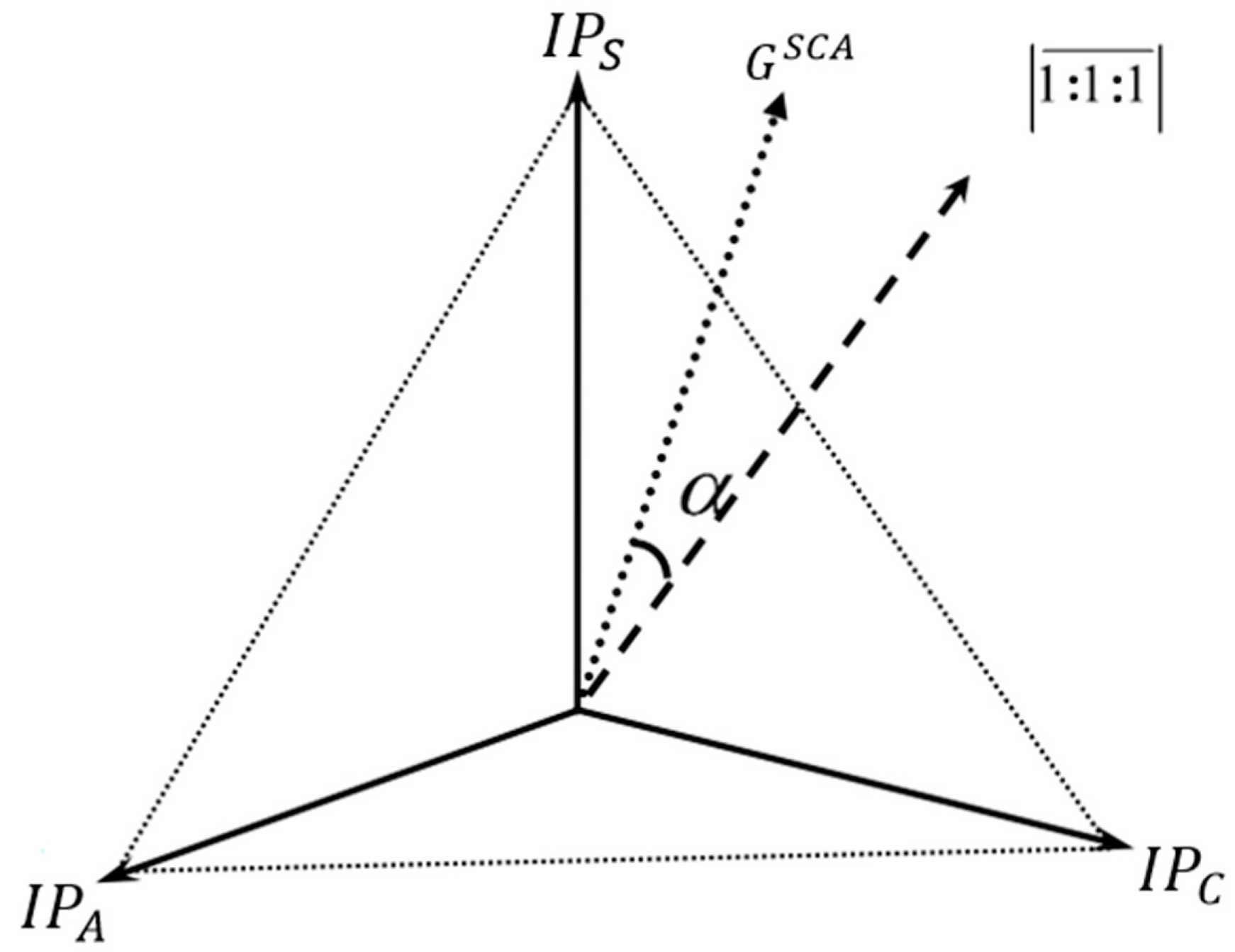
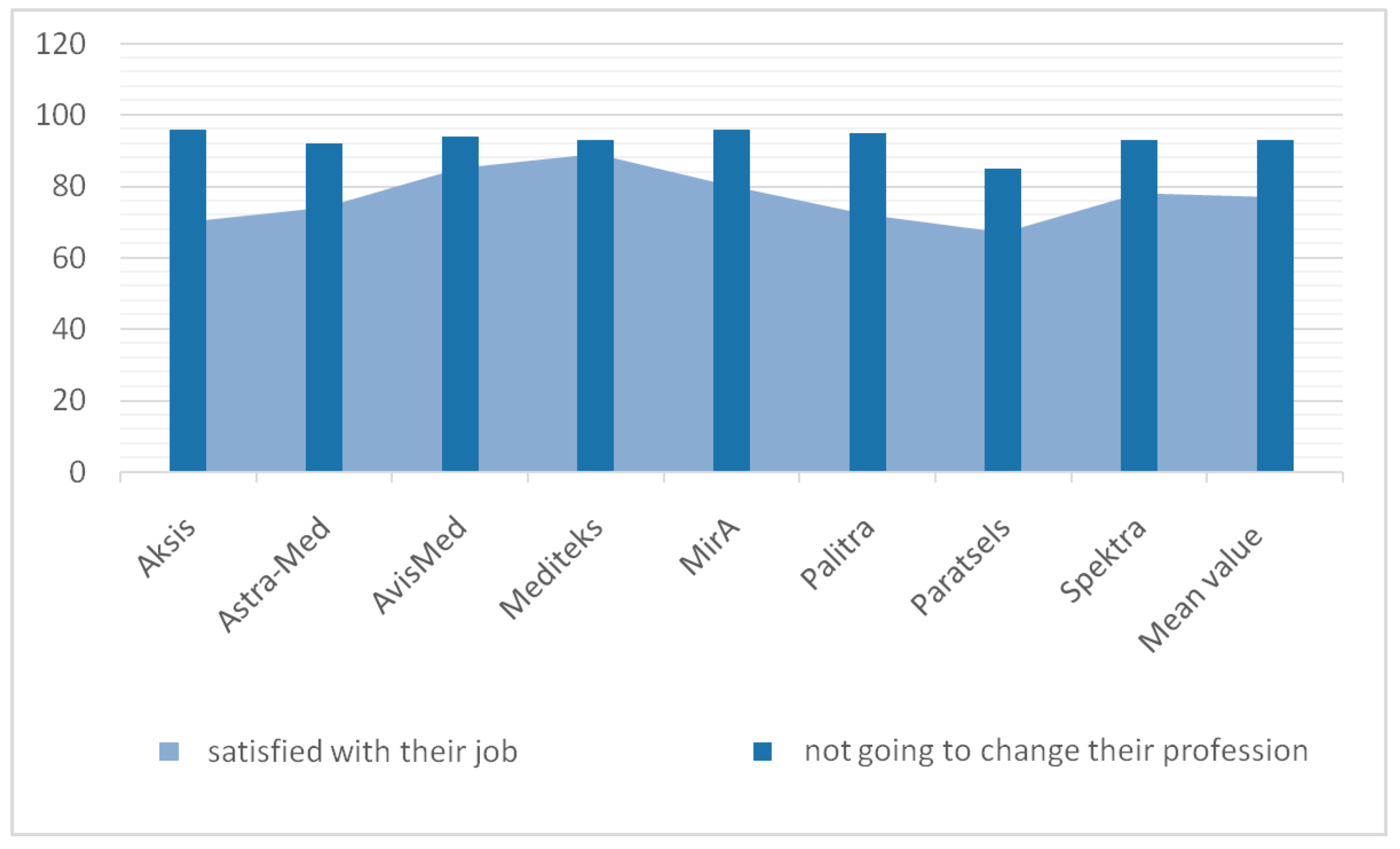
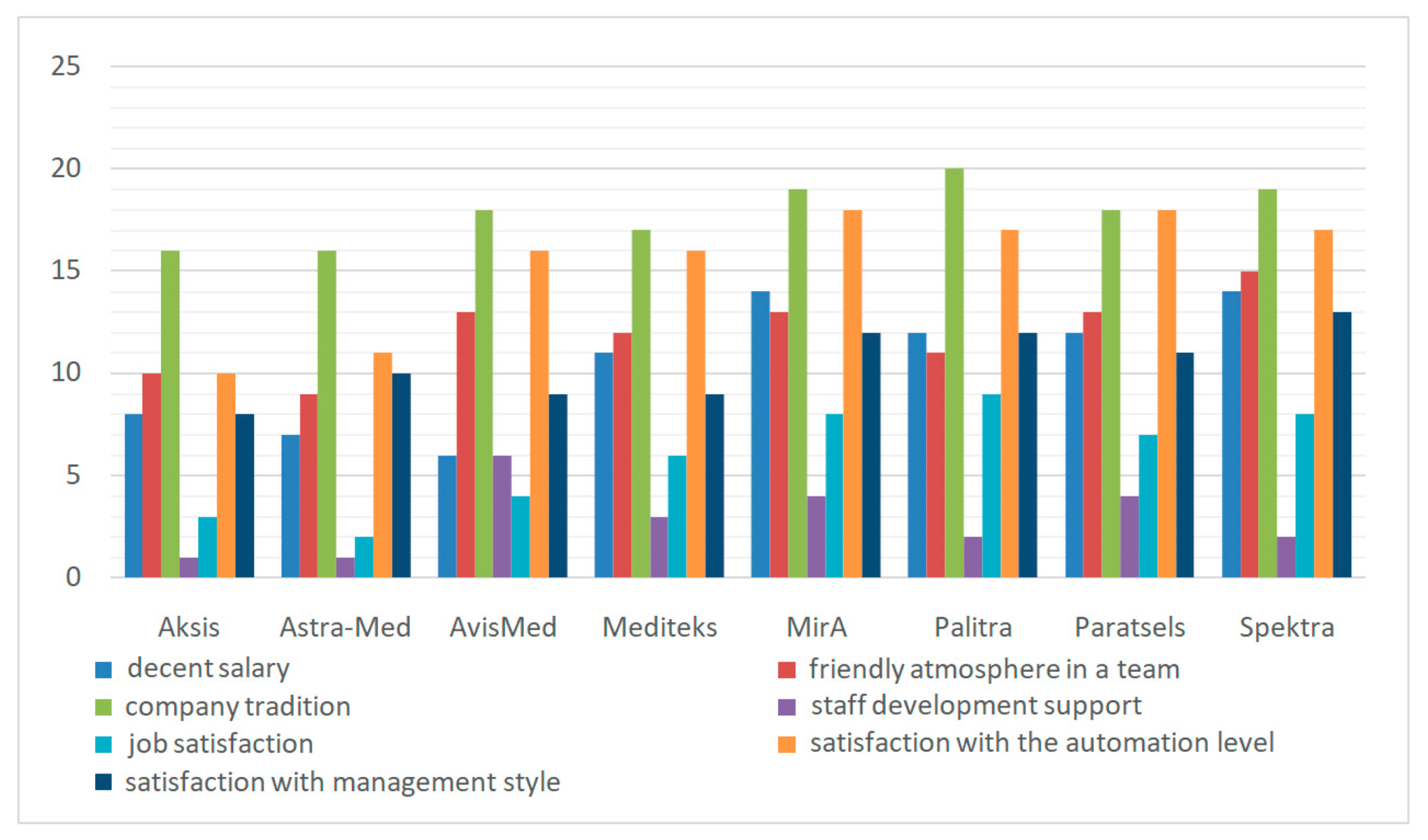
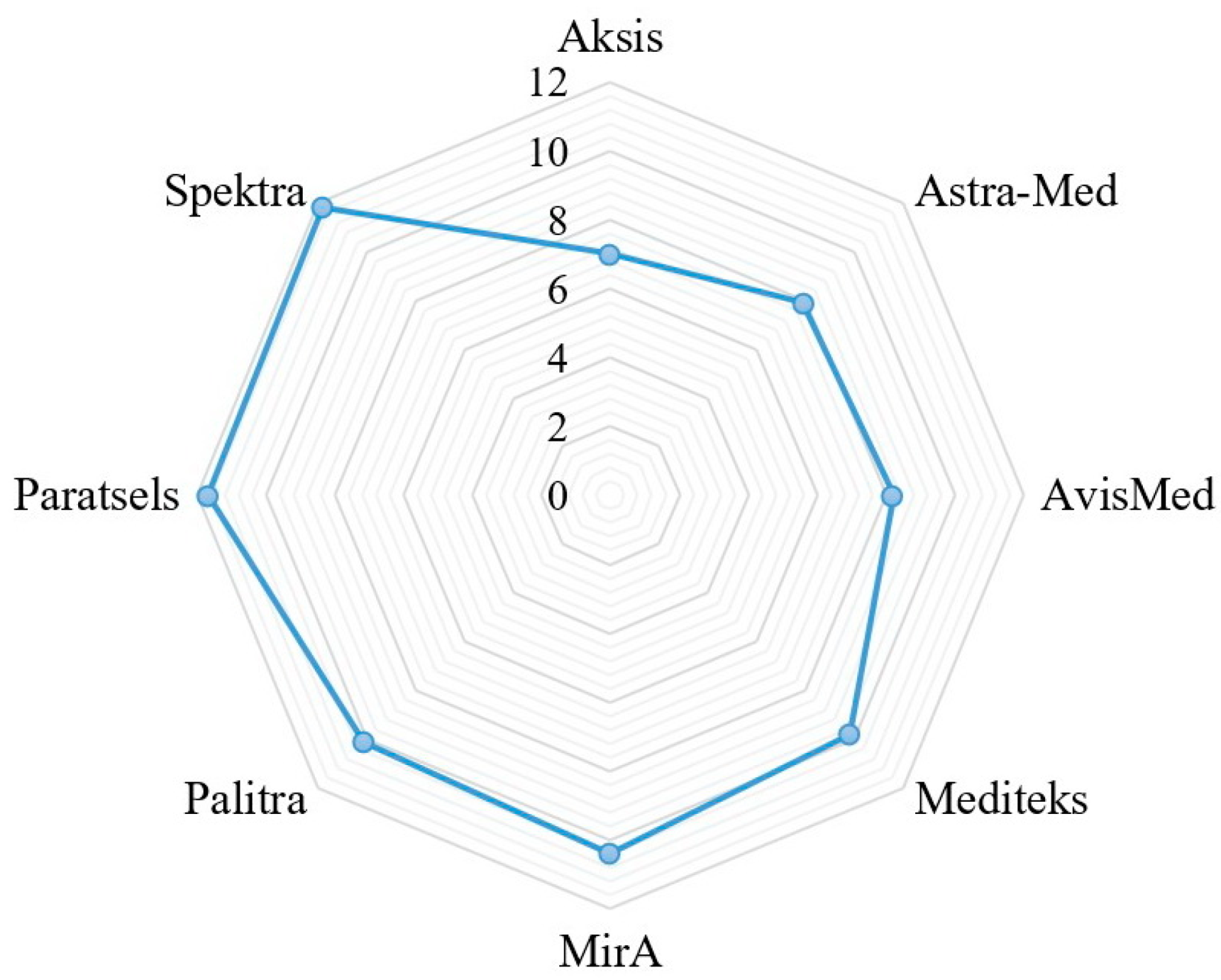
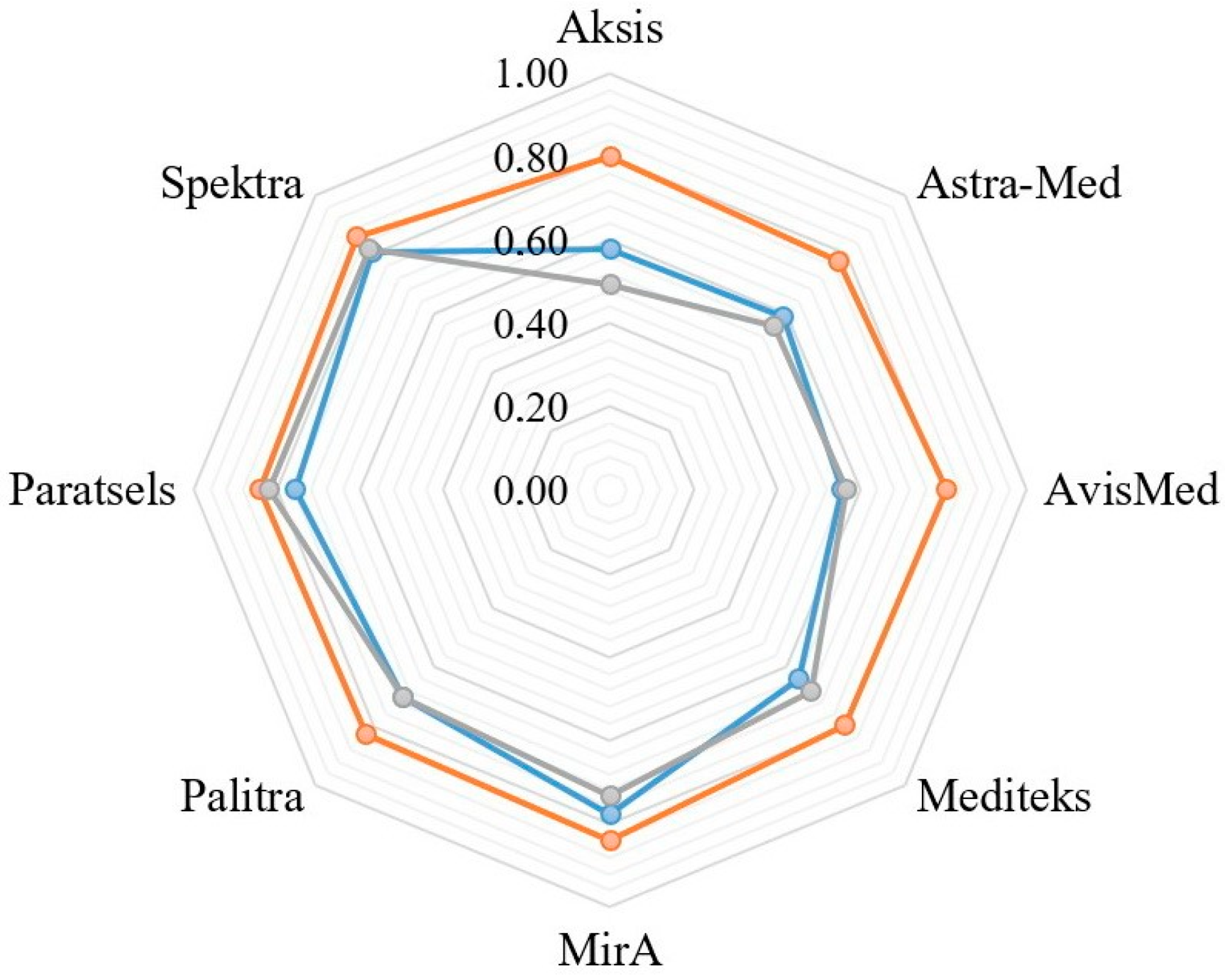

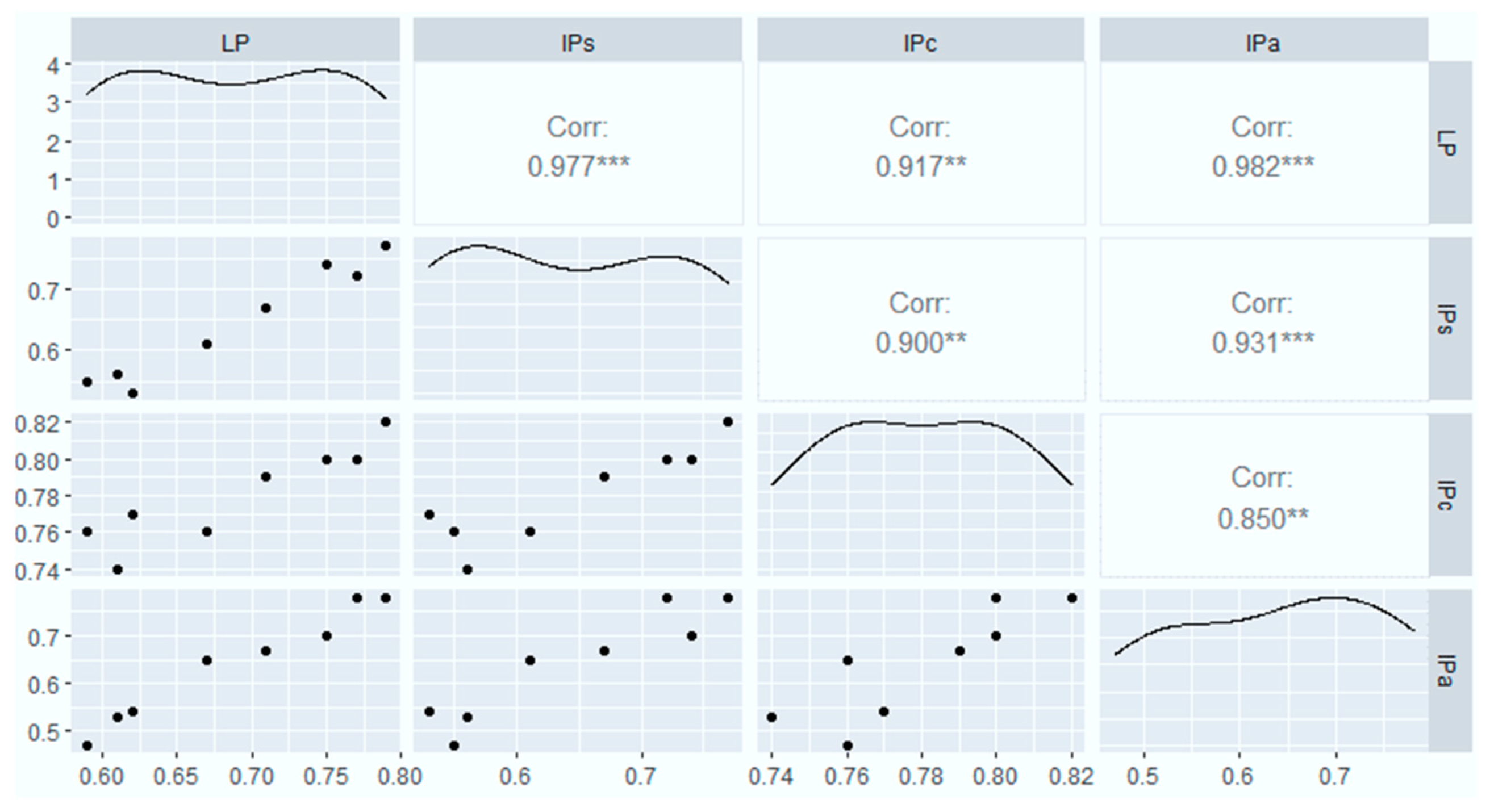
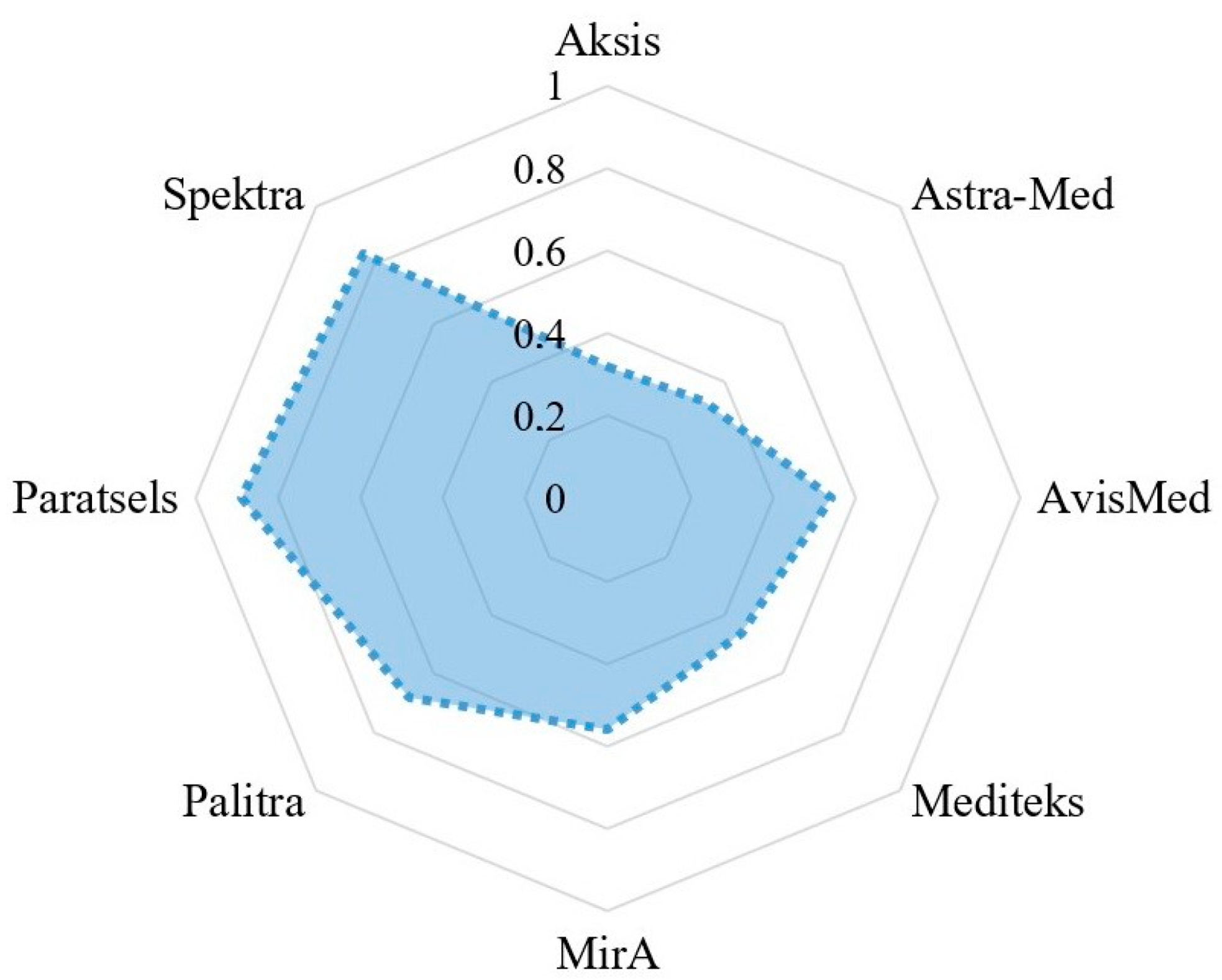
| Company | LP | The Level of Leadership Potential in the Context of a Company’s Intellectualization | |||
|---|---|---|---|---|---|
| Aksis | 0.55 | 0.76 | 0.47 | 0.59 | Sufficient |
| Astra-Med | 0.56 | 0.74 | 0.53 | 0.61 | |
| AvisMed | 0.53 | 0.77 | 0.54 | 0.62 | |
| Mediteks | 0.61 | 0.76 | 0.65 | 0.67 | Acceptable |
| MirA | 0.74 | 0.80 | 0.70 | 0.75 | |
| Palitra | 0.67 | 0.79 | 0.67 | 0.71 | |
| Paratsels | 0.72 | 0.80 | 0.78 | 0.77 | |
| Spektra | 0.77 | 0.82 | 0.78 | 0.79 |
| Indicators | k for the Bilateral Critical Region | |
|---|---|---|
| IPS, IPC | 4.68 | (0.01, 6) = 3.73 |
| IPS, IPA | 5.84 | |
| IPC, IPA | 3.76 |
| Company | IPS | IPC | IPA | LP | ||||
|---|---|---|---|---|---|---|---|---|
| Value | Rank | Value | Rank | Value | Rank | Value | Rank | |
| Aksis | 0.56 | 7 | 0.76 | 6–7 | 0.47 | 8 | 0.59 | 8 |
| Astra-Med | 0.57 | 6 | 0.75 | 8 | 0.54 | 6 | 0.62 | 6 |
| AvisMed | 0.54 | 8 | 0.78 | 5 | 0.55 | 7 | 0.63 | 7 |
| Mediteks | 0.62 | 5 | 0.77 | 6–7 | 0.66 | 5 | 0.68 | 5 |
| MirA | 0.75 | 2 | 0.81 | 2–3 | 0.71 | 3 | 0.76 | 3 |
| Palitra | 0.68 | 4 | 0.80 | 4 | 0.68 | 4 | 0.72 | 4 |
| Paratsels | 0.73 | 3 | 0.81 | 2–3 | 0.79 | 2 | 0.76 | 2 |
| Spektra | 0.78 | 1 | 0.83 | 1 | 0.79 | 1 | 0.80 | 1 |
| Company | Sides of Basic Leadership Potential | Area of Basic Leadership Potential (S) | ||
|---|---|---|---|---|
| a1 (IPS) | a2 (IPC) | a3 (IPA) | ||
| Aksis | 0.199 | 0.217 | 0.102 | 0.249 |
| Astra-Med | 0.186 | 0.190 | 0.111 | 0.224 |
| AvisMed | 0.209 | 0.207 | 0.106 | 0.255 |
| Mediteks | 0.195 | 0.196 | 0.149 | 0.280 |
| MirA | 0.224 | 0.218 | 0.194 | 0.391 |
| Palitra | 0.211 | 0.211 | 0.167 | 0.334 |
| Paratsels | 0.220 | 0.232 | 0.212 | 0.428 |
| Spektra | 0.237 | 0.239 | 0.223 | 0.474 |
| Company | Degrees | Reduction Factor (Ω) | Degree of Harmonizing Intellectualization | |
|---|---|---|---|---|
| Aksis | 83.24 | −0.613 | 0.32 | 0.32 |
| Astra-Med | 82.73 | −0.603 | 0.33 | 0.33 |
| AvisMed | 71.64 | −0.388 | 0.54 | 0.54 |
| Mediteks | 75.69 | −0.467 | 0.46 | 0.46 |
| MirA | 70.81 | −0.372 | 0.56 | 0.56 |
| Palitra | 64.51 | −0.250 | 0.68 | 0.68 |
| Paratsels | 53.73 | −0.041 | 0.89 | 0.89 |
| Spektra | 56.46 | −0.094 | 0.84 | 0.84 |
Publisher’s Note: MDPI stays neutral with regard to jurisdictional claims in published maps and institutional affiliations. |
© 2021 by the authors. Licensee MDPI, Basel, Switzerland. This article is an open access article distributed under the terms and conditions of the Creative Commons Attribution (CC BY) license (https://creativecommons.org/licenses/by/4.0/).
Share and Cite
Zhou, D.; Danshina, S.; Kurilova, A.; Lis, M. The Impact of an Enterprise’s Intellectualization on Its Leadership Potential. Sustainability 2021, 13, 9670. https://doi.org/10.3390/su13179670
Zhou D, Danshina S, Kurilova A, Lis M. The Impact of an Enterprise’s Intellectualization on Its Leadership Potential. Sustainability. 2021; 13(17):9670. https://doi.org/10.3390/su13179670
Chicago/Turabian StyleZhou, Dahui, Svetlana Danshina, Anastasia Kurilova, and Marcin Lis. 2021. "The Impact of an Enterprise’s Intellectualization on Its Leadership Potential" Sustainability 13, no. 17: 9670. https://doi.org/10.3390/su13179670






